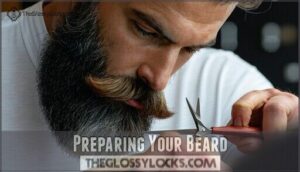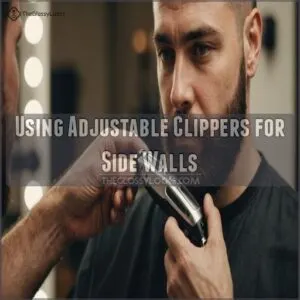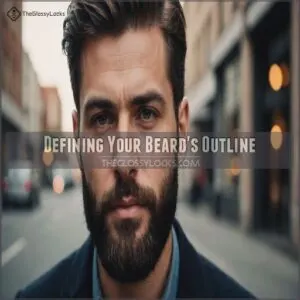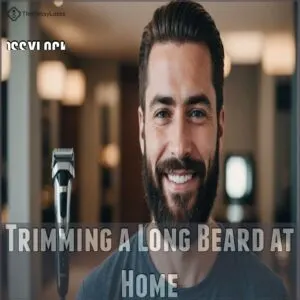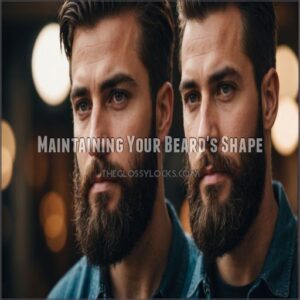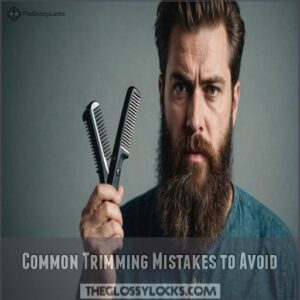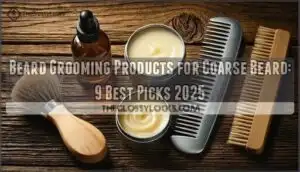This site is supported by our readers. We may earn a commission, at no cost to you, if you purchase through links.
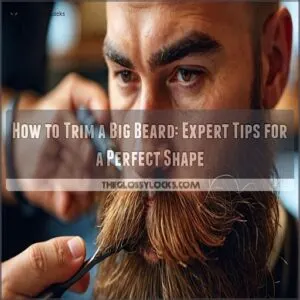 Trimming a big beard is like sculpting a masterpiece.
Trimming a big beard is like sculpting a masterpiece.
First, wash and detangle your beard.
Then, grab a good beard comb and brush your beard in its natural direction.
Use adjustable clippers to trim the sides, aiming for a seamless blend.
Shape the outline with an edge trimmer, paying attention to the top line, base line, and lip line.
Don’t forget to groom your sideburns and mustache.
Solid tools include quality clippers and scissors for those detailed touches.
It’s like pruning a hedge; patience is key.
For more expert tips and secrets, you might want to keep reading further.
Table Of Contents
- Key Takeaways
- Preparing Your Beard
- Trimming The Interior of Your Beard
- Defining Your Beard’s Outline
- Trimming a Long Beard at Home
- Shaping a Long Beard at Home
- Maintaining Your Beard’s Shape
- Common Trimming Mistakes to Avoid
- Advanced Beard Styling Techniques
- Frequently Asked Questions (FAQs)
- Should you trim a long beard?
- How do you cut a beard for a beginner?
- How to trim a beard like a pro?
- How do you trim a mid-length beard?
- How should a full beard be trimmed?
- How do you manage a big beard?
- How to trim a 2 inch beard?
- What does a 12mm beard look like?
- How can I prevent beard split ends?
- What are the best combs for detangling?
- How to manage sensitive skin under a beard?
- Whats the best routine for a shiny beard?
- How do I handle an itchy beard?
- Conclusion
Key Takeaways
- Start by washing and detangling your beard with a gentle cleanser and a wide-tooth comb to maintain moisture and avoid snags.
- Use adjustable clippers and scissors for trimming, focusing on creating a seamless blend on the sides and a precise outline with an edge trimmer.
- Regular maintenance is crucial—trim short beards every two weeks, medium beards monthly, and long beards every six weeks.
- Finish with beard oil and balm to nourish and style your beard for a sleek, polished look.
Preparing Your Beard
To get your beard looking its best, start with a good wash using a gentle beard cleanser that keeps your skin moisturized.
Then, pat it dry and detangle with a wide-tooth pick, making sure it glides through smoothly like a hot knife through butter.
Washing and Detangling Your Beard
Before you get started with beard trimming, give your beard a spa moment with a good wash.
Being mindful that harsh soaps can strip away natural oils and throw off the pH balance of your skin, so consider learning how to wash beard without beard shampoo.
Use quality beard wash products for the best beard care, and make it a part of your daily routine.
After washing, gently pat it dry.
Then, grab your detangling tools—perhaps a trusty wide-tooth beard comb—to avoid any frustrating snarls.
Trimming The Interior of Your Beard
Trimming the interior of your beard can feel like taming a wild creature, but with adjustable clippers, you’re in control.
Carefully angle the clippers as you glide them down the side walls, ensuring a seamless blend that even a barber would envy.
Using Adjustable Clippers for Side Walls
You’ve washed and detangled, now tackle those side walls with adjustable clippers.
Set them halfway open, and let’s create a balanced beard shape.
Keep things smooth and stylish by following these tips:
- Clipper settings: Make sure they’re precise to maintain the beard length you desire.
- Trimming techniques: Use steady hands for consistent results.
- Blending tips: Focus on reducing harsh lines for a natural look.
Angling Clippers for a Seamless Blend
To achieve a seamless blend, it’s essential to work with the natural flow of your hair, and learning how to blend beard with sideburns can help you master this technique. Wondering how to master that seamless blend for your beard?
Here’s a trick: angle your clippers slightly as you move them downward from your cheeks to the neckline.
To achieve a well-defined jawline and elongate features, consider mastering a beard fade style like the ones outlined in the Beard Fade Guide. This technique creates a natural beard fade that smoothly connects the sideburn blend to your jawline.
To achieve a defined beard shape, it’s essential to determine the correct beard neckline, which can be done by running your fingers from your Adam’s apple to the bottom of your ears and imagining a line that marks the transition from your beard to your neck territory how far down neck should beard go. Avoid typical beard trimming mistakes by practicing these clipper angles, ensuring your beard looks polished and sharp!
Defining Your Beard’s Outline
Now it’s time to define your beard’s outline—think of it as giving your facial hair a sharp, refined look.
Using an edge trimmer, carefully shape the top, bottom, and lip lines for a perfectly sculpted beard.
And remember, practice makes perfect!
Using an Edge Trimmer for a Defined Edge
You’re ready to shape up that beard! With an edge trimmer in hand, getting those crisp lines is within reach. Edge trimmer tips for success:
- Sharp vs. Dull: Sharp blades are your best friend—avoid trimming mistakes!
- Edge trimmer types: Choose wisely; it’s like picking the right dance partner.
- Blade maintenance: Regular sharpening keeps everything smooth.
- Beard care: Don’t rush; enjoy the process.
Trimming The Top Line, Base Line, and Lip Line
Grabbing your edge trimmer tools, let’s tackle those lines.
For perfect beard outline styles, start with the top line techniques; go slow and steady.
Remember, it’s not a race.
Move to base line tips; keep it even.
Don’t forget lip line shaping—just a light touch.
A beard brush and scissors will finesse the overall look.
| Task | Tools | Tips |
|---|---|---|
| Top Line | Edge trimmer | Go slow and steady |
| Base Line | Scissors | Keep it even |
| Lip Line | Beard brush | Light touch for finesse |
Trimming a Long Beard at Home
Got a big beard that’s starting to look like a wild forest?
Don’t worry, you can tame it at home with just a pair of clippers for the bulk and scissors for those pesky stragglers.
Using Clippers for Bulk Trimming
An electric trimmer is your best friend for bulk trimming your beard.
Before you begin, use a gentle beard cleanser to prevent flakiness and detangle with a wide-tooth pick to avoid breakage, as seen in pre-trim prep for long beards here.
Start by selecting the right clipper blade; this is important for achieving your desired look without going overboard.
Sweep the trimmer upwards, working from the neck to cheeks.
Keep things even for a polished finish.
- Clipper blade selection matters.
- Trim upwards consistently.
- Check for evenness frequently.
Using Scissors for Detailed Trimming
For fine-tuning your beard, pick up those trusty scissors for precise trimming.
Think of it as sculpting a masterpiece—carefully snip away rogue hairs, focusing on symmetry and balance.
Mastering scissor cuts means patience and steady hands, so take your time.
It’s like shaping a bonsai tree; slow and deliberate wins the race in beard styling and maintenance at home.
Shaping a Long Beard at Home
You’re about to shape your long beard at home, so let’s get started.
First off, get cozy with reference images of beard styles you fancy.
This is your roadmap.
Comb out your beard to spot rogue hairs.
Before you start cutting, make sure to wash and detangle your beard with a gentle beard wash routine.
Grab your shaping tools, considering a versatile electric beard trimmer for shaping that offers adjustable length settings for style versatility; scissors for detail and an electric beard trimmer for the heavy lifting.
Focus on the back line and neck line to sculpt those sharp edges.
Want that barber-esque fade?
Tactfully maneuver the clippers with finesse yet caution.
When it’s time to shine, beard oil’s your best bet; it tames and nourishes.
Finally, a dab of beard balm adds the finishing touch, keeping everything polished.
Remember, each snip and clip is a step toward that masterful ‘you’ look.
Maintaining Your Beard’s Shape
Maintaining your beard’s shape isn’t about constant battles with unruly hairs; it’s about regular upkeep.
Think of it like a well-manicured hedge—consistent trimming, depending on your beard’s length, keeps it looking sharp and stylish.
Trimming Frequency for Different Lengths
Wrestling with beard upkeep? The trick’s in the timing! With beards, it’s all about which camp you fall into: for the best results, pick up a beard trimmer from a trusted source like Restovie’s top-rated trimmers.
- Short beards demand trimming every two weeks.
- Medium beards thrive with a monthly trim.
- Long beards? They need the least—just a bit of love every six weeks.
Remember, beard oil and conditioner can also change the game!
Treating Trimming Like Shaping a Hedge
Think of your beard as a hedge that needs regular maintenance.
Start with the right tools, like precision scissors and adjustable clippers, to refine your look.
Remember to trim from the outside inward, managing unruly strands without haste.
And when mistakes happen, step back; even seasoned trimmers encounter snags.
Keep your beard in top shape, much like a prized shrub.
| Tools | Tips |
|---|---|
| Scissors | For precise, single-hair trimming |
| Clippers | Faster trimming for overall shape |
| Beard Oil | Conditions and enhances beard health |
| Wide-tooth Pick | Detangles without pulling |
| Edge Trimmer | Defines sharp lines around your beard |
Common Trimming Mistakes to Avoid
When trimming your beard, it’s all too easy to get carried away and snip off more than you intended.
Before you know it, a minor adjustment could turn into a major grooming blunder, so sometimes it’s best to take a step back and reassess.
Stepping Away to Avoid Over-Trimming
A moment’s pause can save your beard from disaster.
When trimming, stepping away might be your best tool against over-trimming consequences.
Use sharp beard trimming scissors to help you work more accurately.
Beard trimming anxiety creeps up if you rush.
Visualize before snipping, then exercise patience.
If doubt hits, take breaks.
This beard advice guarantees you’ll master the art of grooming without the dreaded realization of going too short.
Advanced Beard Styling Techniques
In terms of advanced beard styling techniques, mastering the cheek line, back line, and neck line is like taming a wild beast, requiring both finesse and precision.
You’ll find that using a combination of trimmers and scissors can help you craft a custom look that’s as unique as you are, adding flair to your big beard without losing its rugged charm.
Mastering The Cheek Line, Back Line, and Neck Line
Nailing the perfect beard line symmetry often feels like sculpting a masterpiece.
Start with the cheek line—imagine a smooth fade that matches your face’s natural curve.
To achieve a precise line, consider the importance of visualizing a straight line.
Next, tackle the back line; it should always subtly complement your jawline.
Finally, the neckline shapes your entire look.
Using the right beard line tools here is key—trust me, it’s worth it!
Using Trimmers and Scissors for a Custom Look
Now you’ve mastered those lines, let’s fine-tune your beard’s shape.
Use trimmers for the bulk of the work, setting them to your desired length.
To add the finishing touches, consider using a beard balm product.
Then, grab those scissors for precision cutting.
Snip away any stray hairs, creating a perfectly sculpted look.
Remember, patience is key with Beard Trimming Techniques; take your time for a flawless finish.
To achieve a perfect shape, consider investing in a quality beard trimmer, as described in How to Maintain a Short Beard, which explains the importance of cordless, blade types, and features. Experiment with Clipper Settings and find your perfect Beard Style Inspiration!
Frequently Asked Questions (FAQs)
Should you trim a long beard?
Trimming a long beard is essential for keeping its shape crisp and stylish.
Regular trims prevent split ends, tame unruly hairs, and maintain a polished look.
But be patient—your beard deserves a little TLC for perfection.
How do you cut a beard for a beginner?
Think you might mess up? No worries!
Start by combing your beard to detangle it, trim cautiously with clippers set to a longer guard, and use scissors for precision.
Remember, practice makes perfect—you’ll get the hang of it!
How to trim a beard like a pro?
Grab your clippers and scissors, then envision your desired look.
Start trimming from outside in, using clippers for clean lines and scissors for precision.
Detangle, shape carefully, and finish by applying nourishing beard oil to keep it sleek.
How do you trim a mid-length beard?
Your mid-length beard, a canvas of potential, deserves careful trimming.
Start by combing it out.
Use clippers for the edges.
Then, use scissors to snip stray hairs.
Finish with beard oil for a dashing, well-kept look.
How should a full beard be trimmed?
First, comb it out. Then, use clippers for the bulk, followed by scissors for detail. Don’t forget the beard oil afterward; it’ll make you feel like a lumberjack king!
How do you manage a big beard?
Managing a big beard involves regular washing with a gentle cleanser, detangling with a wide-tooth pick, and trimming for shape.
Use beard oil to keep it soft and brush it regularly for style and smoothness.
How to trim a 2 inch beard?
Tackle trimming a 2-inch beard like a pro by using a quality trimmer with an adjustable guard.
Symmetry is key, so start from your sideburns, working downward.
Don’t forget to comb through, checking for stray hairs.
What does a 12mm beard look like?
To achieve the perfect shape, understanding your beard type is key, and you can learn more about how to shape a short beard based on your unique facial features. A 12mm beard showcases a scruffy yet tidy look, falling just shy of a short beard style.
It’s perfect for anyone wanting a masculine appearance without committing to lengthy grooming sessions.
Embrace the rugged charm!
How can I prevent beard split ends?
You’re tired of those pesky split ends ruining your beard’s glory?
Keep it hydrated with beard oil, avoid over-washing, and trim regularly.
Think of it like pruning a bush—snip those ends to keep it lush!
What are the best combs for detangling?
Is there anything more frustrating than a tangled mess in your beard?
A wide-tooth comb works wonders, gently detangling those knotted hairs without tugging, while wooden combs offer static-free, smooth glides for a sleek, manageable beard.
How to manage sensitive skin under a beard?
Sensitive skin under your beard requires gentle care.
Use a mild beard cleanser, pat it dry, apply an alcohol-free beard oil to soothe irritation, and regularly moisturize.
Don’t forget to avoid harsh grooming products—your face will thank you!
Whats the best routine for a shiny beard?
Wash, condition, and oil your beard daily.
Brush regularly to distribute oils, promoting shine.
Trim split ends; a healthy beard shines best!
Experiment with beard balms for extra luster.
You’ll rock that shine!
How do I handle an itchy beard?
Dealing with an itchy beard? Try washing it with a gentle cleanser, then apply beard oil to moisturize and soothe.
Regularly brush your beard to distribute natural oils and exfoliate your skin, easing the itchiness.
Conclusion
Worried it’s too complex to tackle? Trimming a big beard doesn’t have to be a challenging task.
With a bit of practice, you’ll master the art of shaping your mane into perfection. Remember, it’s like sculpting a work of art; patience and the right tools make a difference.
Tackle each step confidently, from washing and detangling to defining and maintaining the perfect shape.
Soon, maintaining a big beard will become second nature.

